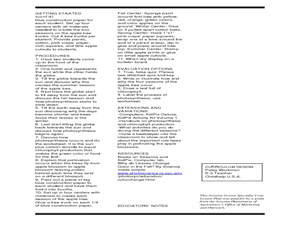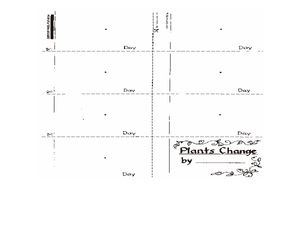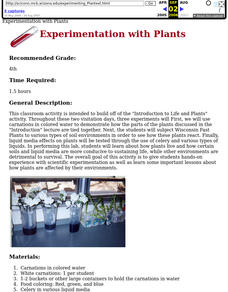Curated OER
Electrophoresis Analogy
Students participate in a simulation of electrophoresis separation of DNA fragments. They link arms to form DNA fragments with each student representing a nucleotide. As they move through an obstacle course they discover how fragments...
Curated OER
Electrophoresis Protocols
Students explain how an agarose gel is poured and DNA is loaded into the wells of the gel. They practice the technique of pouring and loading an agarose gel and participate in a teacher demonstration.
Curated OER
A is for Apple
Learners participate in a variety of activities to learn about apples. Students graph apples, learn about apple uses, taste apples, and observe what happens when apples are dipped in lemon juice.
Curated OER
Apple: Bare to Pick
Students investigate the seasons of the apple tree. In tree seasons instructional activity, students use a sun model and a globe to study the tilt of the Earth to create the seasons. Students discuss the tilt and the seasons. Students...
Curated OER
Apple: Seed to Tree
Students grow seeds of an apple and learn about Johnny Appleseed. In this apples lesson plan, students map Johnny Appleseed's travels, learn how he got his name, compare different Johnny Appleseed books, and grow apple seeds themselves.
Curated OER
Do the Honeybee Dance!
Pupils use dances to learn about honeybees and how they communicate. In this honeybee lesson, students discuss how bees communicate. Pupils study diagrams of dances and practice them. Students locate special treats in bags to study...
Curated OER
How Busy Are Bees?
Students research the jobs of bees. In this timeline lesson plan, students map out each of the six different jobs a worker bee does in its lifetime. They create a timeline and then retell the job descriptions.
Curated OER
Let's Make Stew!
Students investigate how to create a vegetable garden and complete related activities. In this vegetable garden instructional activity, students receive agriculture notebooks to complete vocabulary for the gardening instructional...
Curated OER
Plant Seedling
Students label seed parts and plant seeds. In this seeds lesson plan, students observe and learn about how seeds play a huge role in all plants and food.
Curated OER
Soggy Seeds
Students conduct experiments to learn about seed germination. For this seed germination lesson, students write a hypothesis for the seed experiment. students complete the experiment for seed germination and graph the data obtained from...
Curated OER
Don't Wait, Just Propagate
Students explore the process of growing plants from seed. In this propagation lesson, students examine methods of propagation and determine how to rapidly propagate plant species. Students listen to a lecture informing them on the topic...
Curated OER
If It Smells Good, Is Edible, and Attracts Wildlife, Then It's a Practical Garden
Students explore landscape design. In this practical gardening lesson, students design landscape plans that call for shrubs, trees, and plants that can be used for aesthetics, cooking, and wildlife.
Curated OER
Introduction to Organs/Organ Systems via Frog Dissection
Young scholars are to create, in groups of four, the insides of a frog. This is in preparation for the frog dissection that will follow this introductory lesson plan. Students can begin predicting what the inside of the frog will look...
Curated OER
Bug Eyes
Third graders observe, predict, record and report on a series of experiments with a praying mantid to test its visual acuity. They study the parts of an eye and compare human and mantid eyes.
Curated OER
We Are All In This Together
Third graders observe four different arthropods.Students find, observe, discuss and record similarities and differences among and between insects and people. They appreciate diversity in and recognize unity of all people.
Curated OER
The Behavior of Ants
Students use the steps of the Scientific Method to develop and test their own ideas through experimentation with ants.
Curated OER
Experimentation With Plants
Fourth graders experiment with different varieties of plants and draw conclusions after performing a series of lab activities. A very helpful student worksheet is given. This is a nicely done introductory lesson plan for life science.
Curated OER
Minerals of the Earth
Students learn and practice identifying Earth's minerals and their properties. Working in small groups, they evaluate minerals. This is a well-described lesson plan, which students enjoy.
Curated OER
The Honey Bee Body
Learners construct a paper honey bee to learn the six major parts of a bee and other insects. They compare their own body parts to those of bees. They utilize activity sheets that are imbedded in this plan.
Curated OER
Archaeology Preservation Lab
Students imagine themselves excavating their classroom 5000 years in the future. They discuss what they find there, what items be preserved and which not, and what the objects tell about the people who lived there.
Curated OER
'Round and 'Round it Goes!
Learners discuss and interpret background knowledge on poster copy given on the water cycle. Students complete the included activity sheets using the poster as a reference in small groups. Learners identify and name where water can be...
Curated OER
It'll Go With the Flow...
Students construct a water table elevation contour map and consider the direction and rate of groundwater flow to predict the actual runoff pattern. They discuss their findings and evaluate a hypothetical landfill site based on data...
Curated OER
Where Does it Come From?...Where Does it Go?
Students summarize and illustrate how a water treatment plant and wastewater treatment plant work. Students describe the source of water for their community and the adequacy of groundwater to meet the community's needs. Students also...
Curated OER
A Pox No Longer Upon Us
Tenth graders research the development and use of vaccines. They examine historical documents for qualitative observations and the basis of immunization. They examine primary and secondary immune responses as they relate to the...
Other popular searches
- State of Arizona
- Miranda v. Arizona
- Uss Arizona
- Arizona History
- Arizona Geographic Alliance
- U.s.s. Arizona
- Desert Animals in Arizona
- Arizona Legislators
- Arizona Native Americans
- Great Aunt Arizona
- Indigenous People of Arizona
- Miranda v Arizona

























